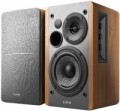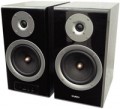Sensitivity
Sensitivity characterizes the loudness of the speakers when a signal of a certain power is applied to them. The higher this indicator, the higher the volume will be with the same characteristics of the signal source; simply put, on the same computer and the same volume settings, more sensitive speakers will play louder.
In general, an indicator of 85 dB is considered good, 90 dB and above is excellent. On the other hand, computer speakers rarely need a very high volume — they are usually located close to the user and are designed only for him. So in general, this parameter can be ignored.
Signal-to-noise ratio
The ratio of the level of the useful signal (actually reproduced sound) to the level of extraneous noise provided by the speaker amplifier in normal mode.
Any amplifier inevitably creates its own noise; You can't get rid of them, but you can reduce their level. The higher the signal-to-noise ratio, the clearer the sound will be, the less noticeable extraneous interference will be. In modern computer speakers, this figure can vary from 52 – 55 dB (the minimum figure so that the noise does not cause much discomfort) to 90 – 95 dB (comparable to fairly advanced Hi-Fi equipment). However, note that the signal-to-noise ratio is far from the only parameter that affects the sound quality, and its high value does not guarantee a pleasant sound from the speakers.
Frequency range
The range of audio frequencies supported by acoustics. The wider this range — the fuller the reproduced sound, the lower the likelihood that some of these details at low or high frequencies will remain “behind the scenes”. At the same time, the human ear is able to hear frequencies of the order of 16 – 22,000 Hz, and with age, this range narrows even more. In modern audio equipment, especially at the top level, there may be more extensive ranges, but from a practical point of view, this does not make much sense. In addition, it is worth noting that a wide frequency range in itself does not guarantee high-quality sound — a lot also depends on the frequency response.
Speaker output
Total speaker power rating — the sum of the power ratings of all components (front, rear, centre, etc.)
Rated usually means the highest average sound power that the speakers can produce without overloading and damage. Individual peaks of sound can significantly exceed this figure, but it is the average value that is key — in particular, it is it that determines the overall loudness of the acoustics. However it should be borne in mind here that in sets with a subwoofer, the latter can account for about half of the total power of the entire system, while the actual volume is determined mainly by the main speakers. In fact, this means that with equal total power, acoustics with a subwoofer can sound noticeably quieter than a model without a subwoofer: for example, a 2.0 system at 20 W will have 10 W per main channel, while in a 2.1 model at 20 W with 10- watt subwoofer on the main speakers will have only 5 watts.
As for specific values, in the quietest modern PC speakers, the power
does not exceed 10 watts. An indicator of
10 – 25 W can be called relatively modest,
25 – 50 W — average, and values of
50 – 100 W and
above are found mainly in sets with subwoofers, where a significant part of the power falls on the bass speaker (although there are also ordinary stereo speakers with similar features).
...
Theoretically, the power of acoustics also affects its compatibility with a specific amplifier: speakers should not be inferior to it in terms of rated power, otherwise sound distortion and even equipment damage are possible. However, computer acoustics in the vast majority of cases are used with their own amplifiers, optimally matched to the speakers installed in the speakers. So this moment becomes relevant only in some very specific cases — for example, when replacing a complete external amplifier (see below) with another one.Front
The power rating of each individual front speaker provided in the speaker system. This parameter can be specified for a system with any number of speakers (see above) — all sound formats used in computer acoustics provide a pair of front speakers.
In the most general terms, the higher the power, the louder the speaker is capable of sounding. For more information about this parameter, see "Total power" above. Also note here that for stereo systems without a subwoofer, the power of one front channel is half of the total power; in more advanced acoustics, the power ratio between the channels may be different.
Detachable cable
The presence
of detachable cables will save you from possible damage to the device associated with bending the wires. If such an incident occurs, an easy replacement of the wire with a new one allows you to continue using the speakers, and not carry them to a service centre. However, this solution is mainly used in higher-level models, which affects the cost. At the same time, not only audio cables can be removable, for which connectors are provided (according to the classics, this is RCA), but also the power cable.
Volume control
The location of the own volume control provided in the speakers. In modern computer speakers, there are regulators installed in the
front,
back,
side,
top,
on the signal cable, on the amplifier and on the remote control (the latter can be either the only regulator or in addition to the regulator with a different location; see below for details). Here are the features of each option:
— Front. The most popular arrangement nowadays: the front panel of the speaker is the easiest to reach, the regulator can be twisted at any time without any problems, and even if the speakers are tightly surrounded by foreign objects from the back and sides, the front panel usually remains free. Of the shortcomings, one can only note the moment that not everyone likes the extra handles on the front panel of the speaker — however, this is a purely aesthetic nuance that does not affect convenience.
— Behind. The knob mounted on the rear panel of the speaker is not very convenient for frequent volume changes — you usually have to find it by touch, and some free space around the speaker is required to access it. So on such speakers it is most convenient to initially select a certain optimal sound level, and then, if necessary, adjust the volume through the computer's software settings and not reach out to the regul
...ator once again. Therefore, this option is quite rare. On the other hand, such invisibility has its advantages: acoustics acquires the most accurate appearance, without unnecessary small elements on the outside.
— Sideways. A kind of compromise between the two options described above: the regulator is not as noticeable as the front one, and at the same time it is easier to get to it than the rear one. However there should be enough free space on the corresponding side of the speaker for this, but this drawback is not particularly critical. So the lateral arrangement is found, although less often than the anterior one, but noticeably more often than the posterior one.
— Above. Pretty specific option. In terms of general specifics, it is similar to the side arrangement described above, however, for a number of reasons it is extremely rare — in speakers of non-standard design, as well as in some sets in which the system control is located on the subwoofer (this component is often installed on the floor, and the top position of the regulator is the most convenient).
— On the signal cable. A regulator placed directly on the wire carrying the audio signal. It is used mainly in inexpensive compact speakers: it is easier and cheaper to install a regulator in this way than to build it into a case, and the dimensions of the case itself can be reduced due to the absence of “extra” parts inside.
— On the amplifier. Option for models with external amplifier (see above). It is the parameters of the amplifier that determine the volume of the sound, so it is more logical to place the volume control on it, and not on one of the speakers. Theoretically, the specific location of the regulator can be different; in fact, this knob (like other controls) is usually mounted on the front panel. Note that such equipment is often supplemented by a regulator on the remote control (see below) — the amplifier is not always conveniently located, for frequent adjustments it is more convenient to use the remote control.
— On the remote control. The controller mounted on the remote control — this can be either a wired or wireless accessory (see "Remote control"). Actually, the presence of a remote control is almost guaranteed to mean the presence of a volume control in it, exceptions are extremely rare; and if there are two such consoles (wired and wireless), then the regulators are often installed in both. Also note that volume control from the remote control can be supplemented by a knob located in any of the places described above (except for the signal cable).
